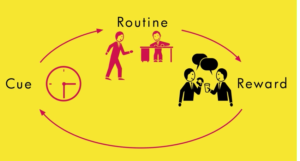Coaching isn't about telling people what you would do or even giving advice. Great coaches action slower by staying curious longer. Questions are the very best tools for the curious to use. Incorporating purposeful questions into a coaching habit ensures you help develop people and your business progresses.
Stop giving advice and start coaching might strike you as well, strange advice. Everyone can use good advice, right?
Not necessarily.
Most leaders want to help their people and teams get through the work and the tough stuff. Giving an answer or advice brings instant gratification. Offering our knowledge feels good and the right thing to do.
Giving answers is faster, it’s helpful, and it perhaps quicker. What’s absent however is learning, development and growth.
The alternative – resist the temptation to “help” and build in more coach-like behaviors.
Coaching means playing for the long game. People grow during that long game. What you get in return far exceeds any outcomes yielded in an environment where telling and advice rule the day.
Giving advice can sometimes get something done, coaching inspires people to
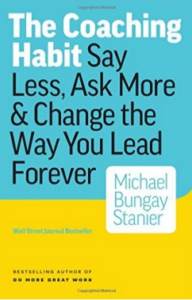
What’s The Difference?
Let’s start by saying that sitting with someone, having a 1:1 or otherwise does not mean you are coaching. It could, but it’s equally likely you aren’t.
A foundational premise of the best selling book The Coaching Habit by Michael Bungay Stanier is “say less, ask more.”
Coaching means you action slower by staying curious longer.
Stay curious longer. Give that a think.
How do you do this – by using questions.
In coaching, there is no telling. There are more questions and less advice.
Why Coaching Over Advice Matters So Much
When you build a coaching habit you deal with “three viscous circles” for managers according to Bungay Stanier:
- Creating overdependence – if everything requires your help or permission, there is a downward spiral of productivity and engagement. People hold back rather than push into issues and problems.
- Getting overwhelmed – if your pile continues to mount with all the work you do for others, the harder it is to focus. Overwhelm takes hold.
- Becoming disconnected – when everything is a priority, nothing is a priority. It is harder and harder to discern what matters.
Other benefits of coaching versus directing or advice giving:
You don’t waste time dealing with the wrong problem. It’s easy in fix-it mode (rather than listening, exploring) to inadvertently blow right by the underlying problem (s).
You help people learn and grow. Advice is overrated. People don’t learn by being told. They learn through thinking, doing, reflecting. Good coaching by its nature enables this.
Finally, you can see how coaching is the companion to delegating. They go together, or generally don’t go at all.
Habits Rule!
As Charles Duhigg explains in The Power Of Habit, about 45% of our behaviors are habits, not conscious decisions we make every day.
Yikes.
He goes on to define that every habit has a cue, a routine, and a reward. Building new coaching habits require focusing on the cues or signals that influence how we act. Typical cues include location, time, emotional state, other people and immediately proceeding action.
The cadence for building a new habit is s follows:
When the cue happens, instead of doing the old habit, I will do the new habit.
More below on a few coaching-related examples.
FYI – short TED Talk on triggers and creating new habits.
Know Thy Self And Be Open To What You See
As with all personal and leadership development efforts for managers and leaders, it requires self-knowledge. Many managers think they are a) coaching and b) doing it well. Employee engagement levels suggest otherwise.
It’s important to understand your natural tendencies and self-identify if and how your interactions are coaching like (or not)?
I love problem-solving. I read the Coaching Habit when it came out several years ago. It had a real impact on me. It forced me to think about my habits. I had plenty but not enough of the most essential to be coach-like.
I had some of it backward.
It was excruciatingly difficult not to try and “add value” by helping with advice or taking something off someone’s plate.
My habit was person comes into my office with a problem; I tried to make it better, they left with a problem solved.
This wasn’t good for either of us.
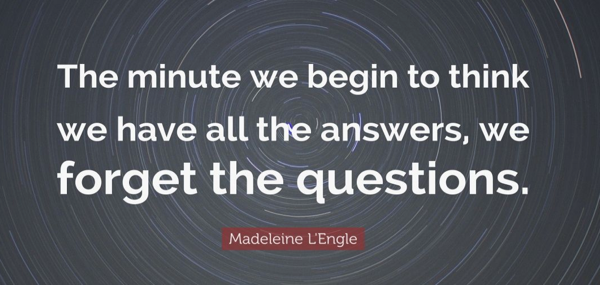
7 Questions To Help You Stop Giving Advice And Start Coaching
The idea of coaching applies to people that work directly for you but also for customers, suppliers, other colleagues and maybe even bosses.
Think about anyone who looks to you for guidance. You can tell and give out advice, or you can help support growth.
As outlined in the coaching habit, here are the 7 essential questions from The Coaching Habit:
- Kickstart – What’s On Your Mind?
- AWE – And What Else?
- Focus – What’s The Real Challenge Here For You?
- Foundation – What Do You Want?
- Lazy – How Can I Help?
- Prioritization – If You Are Saying Yes To This, What Are You Saying No To?
- Learning – What Was Most Useful?
You can see how asking these opening ended questions which focus on them thinking, can activate a meaningful and different conversation.
That said, this isn’t a script. There is a nuance to when and how you use these questions.
Here is some additional commentary on each question to help you stop giving advice and start coaching more:
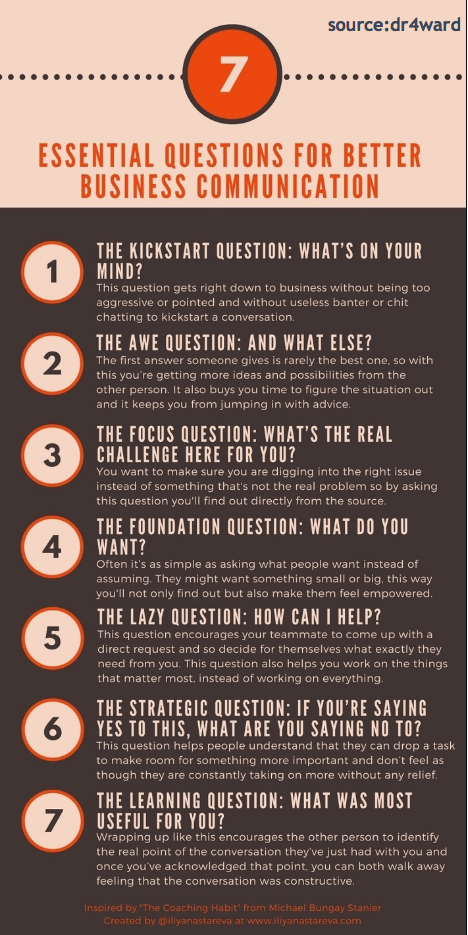
(To hear a role play by the author of a conversation using these questions – check out this episode on Whitney Johnson’s podcast Disrupt Yourself.)
These questions also work in email. While always preferable to talk live, there may be times you can not. These questions can still help you serve up a coach-like approach.
The 3 P’s
The Coaching Habit also talks about the 3 P’s as a structure for what to coach around:
Project – what people are working
People – issues and relationships with those in and around the work
Patterns of behavior – how the person you are coaching is approaching the tasks.
Coaching for development comes about in discussing patters of behavior. It is the most personal and the most impactful. Projects need addressing. It is the business of business. Striking a balance between the two is the ideal scenario to help develop colleagues.

When Advice Is Disguised
Any of us that consider ourselves problem solvers have done and probably are doing this. One of your people is in your office talking about a problem, you have an idea and ask:
Have you thought of your advice.…?
The coaching habit calls this the Fake Question. I love it. They are right.
So let’s think about creating a new habit loop and breaking the Fake Question routine:
When someone keeps going on about a problem with one of their peers, instead of asking “have you thought about saying this to them” (aka a Fake Question), I will ask “what’s the real challenge here for you?”
This approach will get them talking about the real-life challenge for them. You can play through the other questions as and in ways that make sense. The conversation will illuminate and guide towards them solving.
"We live in the world our questions create." — David Cooperrider
— Shane Parrish (@ShaneAParrish) January 20, 2018
Finding Comfort (And So Much More) In Silence
In 5 Ways Being Silent Can Be So Powerful For You, I talked about how silence creates a space that others will fill.
Space is where thinking, reflection, and learning begin to germinate.
If you don’t let the silence hang out there, questions fundamentally don’t matter.
Ask a question and stay curious (and quiet!)
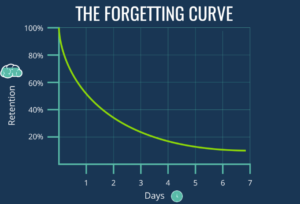
Interrupt The Process Of Forgetting
The book Make It Stick: The Science Of Successful Learning famously talks about learning and how to make things more memorable. The authors suggest you need to:
Interrupt the process of forgetting.
Indeed!
The best way to do this – quick, real-time reflection. In a coaching context, enter the Learning Question “what was most useful for you in the conversation?” helps do just that.
So let’s think about creating a new habit loop:
When we’ve reached the end of our coaching conversation, instead of just letting it end with final pleasantries, I will ask what was most usfeul for you in the conversation.”
This question and the subsequent back and forth drive reflection and activates the learning process. You can then follow with what was most useful for you.
What This Doesn’t Mean
It’s equally important to level set on what it doesn’t mean to stop giving advice and start coaching more.
- Another way to add to your pile. I’m not suggesting you do more. Instead, this is about adjusting. It means framing your conversations differently – both in your role in the discussion and what success looks like.
- You should suspend good judgment. There are times where interceding and giving an answer and more directed advice will make sense.
- Coaching becomes programmatic. Having thoughtful questions should not constitute a script. Questions make it more personal not less unless it feels rehearsed. This is about intent. People sense sincere interest or lack of it. Listening and staying truly curious is the answer.
Two Minute Warning
Reflect on your conversations and coaching behaviors. How do your conversations stack up in contrast to the above approach? Are you staying curious and asking more questions versus telling or giving advice?
Think about, decide on what coaching habits you want to adopt. The above is one approach, but there are other question sets you can consider. As with any new routine you wish to adopt, this will take some practice (and some restraint). Make it part of what you do not an addition
A way of being with each other. – Peter Block, Author Of Flawless Consulting on Coaching
The effects of coaching outpace, by a mile, any advice you could offer.
Coaching, even in small doses, has the power to inspire. Think about people who’ve impacted and inspired you. I’m guessing it wasn’t born out of them telling you what to do or even advice. Together you teased out insights and learnings.
Stay curious and ask more questions.
Good things will follow!


